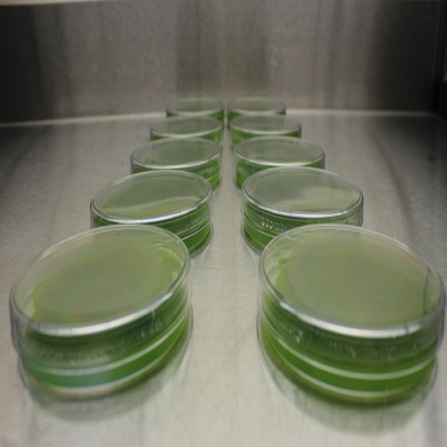ASTM G29 Test for Resistance to Algae
Get A Testing Quote

The ASTM G29 test method evaluates an antimicrobial surface’s ability to resist algal attack. Such testing is important because algae are ubiquitously found in and around bodies of water. Many of these aqueous environments are associated with human activities, such as swimming pools. Under the right conditions, algae can propagate to form large macrofilms that can pervade these structures and render them unsightly and sometimes hazardous. Over time, some algae can deteriorate materials to the point that they need to be replaced.
One way to thwart or eliminate pervasive algal growth on or around human structures is to use materials formulated to resist surface attachment or to otherwise prevent algal growth. To achieve these properties, anti-algal coatings/films are applied to or formulated within materials that come in contact with water. The following summarizes the ASTM G29 testing standard, which aims to evaulate the degree of protection afforded to films integrated with anti-algal additives.
Summary of the ASTM G29 Test
- Surface spreading blue-green algae Oscillatoria sp. is propagated continuously on redwood slats under fluorescent lighting.
- Treated and untreated specimens are suspended in jars containing homongenized Oscillatoria cells under static conditions.
- Test jars are stored in test chambers under 12 hours of light and 12 hours of dark.
- Test jars are reinoculated with fresh algae every 2 to 3 days and the test is completed after 14 days.
- Test specimens are extracted from test jars and evaluated for level of algal growth.
Strengths of the ASTM G29 Test
- The ASTM G29 test method can be used to evaluate virtually any augmented plastic film or coated surface.
- Algal growth is easy to evalutate by visual examination.
- Testing can screen a range of materials or anti-algal agents in just 14 days.
- The method is simple, straighfoward, and cost effective.
Weaknesses of the ASTM G29 Test
- Bacterial contamination may affect the ability of algae to attach to surfaces.
- Only one species of algae is used in the method.
- Multiple replicates may be needed to account for variations in material formulations.
- Some pigmented materials may be harder to judge than others.
Microchem Laboratory is the leading laboratory for the testing of antibacterial and antifungal surfaces and coatings. Algae testing is currently not run by Microchem, this page is for information purposes only.
